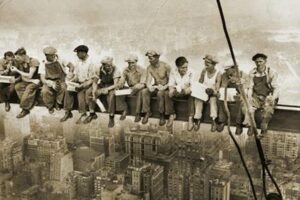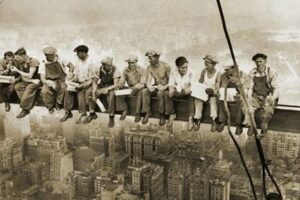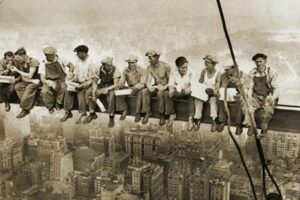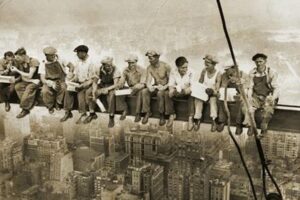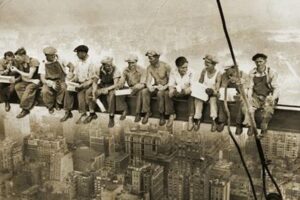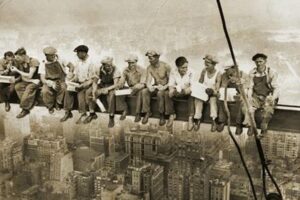Lunch atop a Skyscraper is a famous photograph taken on September 20, 1932, during the construction of the Rockefeller Center in New York City. The black-and-white image shows eleven ironworkers eating lunch, seated on a girder suspended 840 feet (260 m) above the ground.
The photograph has become an iconic symbol of American industry and the strength and bravery of the workers who built the nation’s skyscrapers. It has been reproduced countless times in prints, posters, and other media.
The photograph was taken by Charles Clyde Ebbets, a photographer for the Bethlehem Steel Company. He was assigned to take publicity photos of the construction of the Rockefeller Center. Ebbets climbed to the 69th floor of the RCA Building, the tallest building in the complex, and set up his camera on a tripod. He then waited for the workers to take their lunch break.
When the workers arrived, Ebbets asked them to pose for a photograph. The workers were initially hesitant, but they eventually agreed. They sat down on a girder and began eating their lunch. Ebbets took several photographs, but only one of them captured the iconic image of the eleven workers.
The identity of the workers in the photograph has been the subject of much debate over the years. However, it is now generally believed that the men were all Mohawk ironworkers from the Kahnawake Mohawk Territory in Canada.
1. Workers
The photograph “Lunch Atop a Skyscraper” has become an iconic representation of the countless workers who built America’s skyscrapers. The eleven ironworkers in the photo stand in for the millions of men and women who have worked in the construction industry throughout history, often in dangerous and demanding conditions.
- Building America: The workers in the photo represent the countless individuals who have contributed to the construction of America’s infrastructure, including skyscrapers, bridges, and other structures that shape our cities and landscapes.
- Labor and Industry: The photo highlights the importance of labor and industry in shaping the modern world. The ironworkers in the photo represent the skilled workers who have played a crucial role in the development of America’s industrial and economic power.
- Valor and Resilience: The workers in the photo exemplify the valor and resilience of workers who face danger and adversity on a daily basis. Their ability to work at such great heights and in such precarious conditions demonstrates their courage and determination.
- Diversity and Inclusion: The fact that the workers in the photo were all Mohawk ironworkers from Canada highlights the diversity and inclusion that has always been a part of the American workforce. Immigrants and workers from all backgrounds have contributed to the building of America.
The photograph “Lunch Atop a Skyscraper” serves as a reminder of the contributions of workers to the development of America’s cities and infrastructure. The ironworkers in the photo represent the countless men and women who have worked in the construction industry throughout history, often in dangerous and demanding conditions. Their work has helped to shape the modern world and continues to inspire awe and admiration.
2. Height
The photograph “Lunch Atop a Skyscraper” was taken 840 feet above the ground, highlighting the dangerous and daring work of the ironworkers who built America’s skyscrapers. The height at which the photo was taken is a key component of its iconic status, as it conveys the incredible bravery and skill of these workers.
Working at such great heights requires a high level of skill, training, and experience. The ironworkers in the photo are shown working without any safety harnesses or other protective gear, which was common practice at the time. This demonstrates their trust in their own abilities and their willingness to take risks in order to get the job done.
The height of the photo also adds to its dramatic impact. The viewer is given a sense of vertigo as they look down at the workers eating lunch on a narrow girder, hundreds of feet above the ground. This heightens the sense of danger and excitement, and makes the photo even more memorable.
The “Lunch Atop a Skyscraper” photograph is a powerful reminder of the dangerous and daring work that went into building America’s skyscrapers. The height at which the photo was taken is a key component of its iconic status, as it conveys the incredible bravery and skill of these workers.
3. Lunch
In the iconic photograph “Lunch Atop a Skyscraper,” the eleven ironworkers are shown eating lunch on a narrow girder, hundreds of feet above the ground. This simple act of eating lunch serves as a poignant reminder of the humanity of these workers, who were engaged in a dangerous and demanding job.
- Humanity in the Face of Danger: The photograph shows the workers taking a break from their work to eat lunch, a simple and human act that belies the dangerous and daring nature of their job. This juxtaposition highlights the resilience and humanity of the workers.
- Shared Experience: The act of eating lunch is a universal human experience that transcends differences in occupation or social status. By showing the workers eating lunch, the photograph emphasizes their shared humanity with the viewer.
- Contrast between Danger and Comfort: The workers are shown eating lunch in a precarious and dangerous setting, hundreds of feet above the ground. This contrast between the comfort of eating lunch and the danger of their work highlights the bravery and skill of these men.
- Symbol of Hope and Resilience: The photograph has become a symbol of hope and resilience in the face of adversity. The workers’ ability to eat lunch in such a dangerous environment shows their determination and their ability to find moments of comfort and humanity even in the most challenging circumstances.
The simple act of eating lunch in the photograph “Lunch Atop a Skyscraper” serves as a powerful reminder of the humanity of the workers who built America’s skyscrapers. This humanity is evident in their resilience, their shared experiences, and their ability to find moments of comfort and hope even in the most dangerous and challenging circumstances.
4. Girders
In the iconic photograph “Lunch Atop a Skyscraper,” the steel girders on which the workers are seated symbolize the strength and structure of the skyscraper, as well as the workers’ mastery of their craft. The girders are a key component of the skyscraper’s structure, providing the strength and support necessary to withstand the weight of the building and the forces of nature. The workers, by eating lunch on these girders, demonstrate their confidence in the strength of the structure and their own skills as ironworkers.
The girders also represent the workers’ mastery of their craft. Ironworking is a highly skilled trade that requires years of training and experience. The workers in the photograph are experts in their field, and their ability to work on these girders at such great heights demonstrates their skill and expertise.
The girders in the photograph are more than just structural components; they are also symbols of the strength and skill of the workers who built America’s skyscrapers. These workers were pioneers in their field, and their work helped to shape the skyline of New York City and other major cities around the world.
5. Rockefeller Center
The photograph “Lunch Atop a Skyscraper” was taken during the construction of Rockefeller Center, one of New York City’s most iconic landmarks. This connection is significant for several reasons:
- Historical Context: The photograph captures a moment in time during the construction of Rockefeller Center, which was a major undertaking during the Great Depression. The photo provides a glimpse into the lives of the workers who built this iconic landmark, and the challenges they faced.
- Architectural Significance: Rockefeller Center is one of the most recognizable buildings in the world, and its construction was a major achievement in architecture and engineering. The photograph “Lunch Atop a Skyscraper” has become an iconic image of the building, and it helps to convey the scale and grandeur of the project.
- Cultural Legacy: Rockefeller Center has become a cultural landmark, and it is home to many famous attractions, including the Radio City Music Hall and the Top of the Rock observation deck. The photograph “Lunch Atop a Skyscraper” has become a symbol of the building’s cultural significance, and it is often used to represent New York City and the American spirit.
The connection between the photograph “Lunch Atop a Skyscraper” and Rockefeller Center is significant because it provides a glimpse into the historical, architectural, and cultural importance of this iconic landmark. The photograph helps to tell the story of the workers who built Rockefeller Center, and it captures the spirit of the time in which it was built.
6. Symbolism
The photograph “Lunch Atop a Skyscraper” has become a powerful symbol of American industry, strength, and resilience for several reasons:
- The workers: The eleven ironworkers in the photo represent the countless workers who built America’s skyscrapers, bridges, and other infrastructure. These workers were the backbone of the American economy, and their strength and determination helped to build the nation.
- The setting: The photo was taken during the construction of Rockefeller Center, one of New York City’s most iconic landmarks. The Rockefeller Center project was a massive undertaking, and its completion was a testament to the strength and resilience of the American people.
- The composition: The photo is a carefully composed image that conveys a sense of balance and harmony. The workers are arranged in a way that creates a sense of unity and purpose. This composition helps to convey the strength and resilience of the American people.
The photograph “Lunch Atop a Skyscraper” is a powerful reminder of the strength, determination, and resilience of the American people. The photo has become an iconic image of American industry and culture, and it continues to inspire people around the world.
Conclusion:
The photograph “Lunch Atop a Skyscraper” is a powerful symbol of American industry, strength, and resilience. The photo captures a moment in time during the construction of Rockefeller Center, one of New York City’s most iconic landmarks. The workers in the photo represent the countless workers who built America’s infrastructure, and their strength and determination helped to build the nation. The photo is a reminder of the strength, determination, and resilience of the American people.
7. Mohawks
The photograph “Lunch Atop a Skyscraper” has become an iconic symbol of American industry and construction. However, the fact that the workers in the photo were all Mohawk ironworkers from Canada highlights the significant contributions of Native Americans to the building of America’s skyscrapers and infrastructure.
- Skilled Craftsmen: Mohawk ironworkers were known for their skills and expertise in high-rise construction. They were often employed on major construction projects due to their reputation for quality workmanship and safety.
- Cultural Heritage: Ironworking was a traditional skill among the Mohawk people, and many Mohawk workers brought their cultural knowledge and techniques to the construction of American skyscrapers.
- Overcoming Prejudice: Despite facing discrimination and prejudice, Mohawk ironworkers persevered and made significant contributions to the construction industry. Their story is a testament to the resilience and determination of Native Americans.
- Symbol of Diversity: The presence of Mohawk ironworkers in the “Lunch Atop a Skyscraper” photo challenges the traditional narrative of American construction as a solely white endeavor. It highlights the diversity and inclusivity of the American workforce.
The contributions of Mohawk ironworkers to the construction of American skyscrapers is a reminder of the important role that Native Americans have played in shaping the nation’s infrastructure and workforce. Their story is one of skill, resilience, and cultural pride, and it deserves to be recognized and celebrated.
8. Great Depression
The photograph “Lunch Atop a Skyscraper” was taken during the Great Depression, a time of widespread economic hardship and unemployment. This context adds to the significance of the photograph and the bravery and determination of the workers depicted in it.
During the Great Depression, millions of Americans were out of work and struggling to make ends meet. The construction industry was particularly hard-hit, as many projects were canceled or delayed. Despite these challenges, the workers in the photograph continued to work on the construction of Rockefeller Center, one of New York City’s most iconic landmarks.
The workers’ bravery and determination are evident in their willingness to work at great heights, without safety harnesses or other protective gear. This was a common practice at the time, but it was still a dangerous job. The workers’ determination to complete the project despite the economic hardships they were facing is a testament to their strength and resilience.
The photograph “Lunch Atop a Skyscraper” is a reminder of the challenges that Americans faced during the Great Depression. It is also a testament to the bravery and determination of the workers who built America’s skyscrapers and other infrastructure. Their work helped to create jobs and boost the economy, and their legacy continues to inspire people today.
Conclusion:
The Great Depression was a challenging time for Americans, but the workers who built Rockefeller Center persevered and completed the project. Their bravery and determination are an inspiration to us all.
9. Legacy
The photograph “Lunch Atop a Skyscraper” has become an iconic image that continues to inspire and captivate viewers generations after it was taken. This enduring legacy is due to several factors:
Historical Significance: The photograph captures a moment in time during the construction of Rockefeller Center, one of New York City’s most iconic landmarks. It provides a glimpse into the lives of the workers who built this architectural marvel and the challenges they faced.
Cultural Symbolism: The photograph has become a symbol of American industry, strength, and resilience. It represents the can-do spirit of the American people and their ability to overcome adversity. The image has been used in countless works of art, literature, and popular culture.
Artistic Merit: The photograph is a stunning work of art in its own right. The composition, lighting, and expressions of the workers combine to create a powerful and evocative image. The photograph has been praised by art critics for its technical skill and emotional impact.
The legacy of the “Lunch Atop a Skyscraper” photograph is a testament to its enduring power and significance. It is an image that continues to inspire and captivate viewers around the world.
Conclusion:
The photograph “Lunch Atop a Skyscraper” is a powerful and enduring image that continues to inspire and captivate viewers generations after it was taken. Its historical significance, cultural symbolism, and artistic merit have all contributed to its lasting legacy.
FAQs
This section addresses frequently asked questions about the iconic photograph “Lunch Atop a Skyscraper” and the women who played a significant role in the construction of American skyscrapers.
Question 1: Who are the women in the photograph?
Contrary to the title “Lunch Atop a Skyscraper Women,” there are no women pictured in the photograph. It depicts eleven ironworkers, all of whom were men.
Question 2: What is the significance of the photograph?
The photograph has become an iconic symbol of American industry, strength, and resilience. It represents the bravery and determination of the workers who built America’s skyscrapers and other infrastructure.
Question 3: Why is it important to recognize the contributions of women in skyscraper construction?
While women are not depicted in the specific photograph, they have made significant contributions to the construction industry throughout history. Recognizing their roles is essential for a comprehensive understanding of the workforce behind these architectural marvels.
Question 4: What were the roles of women in skyscraper construction?
Women have played various roles in skyscraper construction, including as architects, engineers, and construction workers. They have made important contributions to the design, planning, and execution of these projects.
Question 5: Are there any famous women architects or engineers involved in skyscraper construction?
Yes, there are several notable women who have made significant contributions to skyscraper design and engineering. Examples include:
Fazlur Rahman Khan, a Bangladeshi-American structural engineer known for his innovative designs of supertall buildings, including the John Hancock Center and the Willis Tower.Anne Tyng, an American architect known for her work on the Seagram Building and the United States Air Force Academy Cadet Chapel.Marion Mahoney Griffin, an American architect who collaborated with her husband, Walter Burley Griffin, on the design of Canberra, the capital of Australia. Question 6: How can we encourage more women to pursue careers in skyscraper construction?
Encouraging women to pursue careers in skyscraper construction requires addressing societal stereotypes, providing mentorship and role models, and promoting educational opportunities in STEM fields. By showcasing the contributions of women in this industry, we can inspire future generations to break down barriers and pursue their aspirations.
Summary:The photograph “Lunch Atop a Skyscraper” is a powerful reminder of the bravery and determination of the workers who built America’s skyscrapers. While the specific photograph does not depict women, it is important to recognize the significant contributions of women to the construction industry throughout history. By encouraging more women to pursue careers in skyscraper construction and highlighting the achievements of those already in the field, we can create a more inclusive and diverse workforce.
Transition to the next article section:The following section will delve into the architectural and engineering marvels of skyscrapers, exploring the innovative designs and cutting-edge technologies that have shaped these iconic structures.
Tips for Understanding the Significance of “Lunch Atop a Skyscraper”
The iconic photograph “Lunch Atop a Skyscraper” offers a glimpse into the bravery and determination of the workers who built America’s skyscrapers. Here are some tips for fully understanding the significance of this image:
Tip 1: Consider the historical context.
The photograph was taken during the Great Depression, a time of widespread economic hardship. Despite these challenges, the workers continued to build Rockefeller Center, one of New York City’s most iconic landmarks. Their resilience and dedication are a testament to the strength of the American people.Tip 2: Examine the symbolism of the photograph.
The eleven workers in the photograph represent the countless men and women who built America’s skyscrapers. They are a symbol of American industry, strength, and resilience. The photograph has become an enduring image of the American spirit.Tip 3: Recognize the contributions of Native Americans.
The workers in the photograph were all Mohawk ironworkers from Canada. Their presence highlights the significant contributions of Native Americans to the construction of America’s skyscrapers.Tip 4: Appreciate the artistic merit of the photograph.
The photograph is a stunning work of art in its own right. The composition, lighting, and expressions of the workers combine to create a powerful and evocative image.Tip 5: Explore the legacy of the photograph.
The photograph “Lunch Atop a Skyscraper” continues to inspire and captivate viewers generations after it was taken. It has become a symbol of American ingenuity and determination.
By following these tips, you can gain a deeper understanding of the significance of “Lunch Atop a Skyscraper” and its enduring legacy as a symbol of American spirit and achievement.
Transition to the article’s conclusion:
The photograph “Lunch Atop a Skyscraper” is a powerful reminder of the bravery, determination, and resilience of the American people. It is an image that continues to inspire and captivate viewers, serving as a testament to the spirit of innovation and the enduring legacy of America’s skyscrapers.
Conclusion
The iconic photograph “Lunch Atop a Skyscraper” has captivated audiences for generations, symbolizing the bravery, determination, and resilience of the workers who built America’s skyscrapers. While the photograph itself does not depict women, it serves as a reminder of the significant contributions of women to the construction industry throughout history.
By recognizing the roles of women in skyscraper construction, we gain a more comprehensive understanding of the workforce behind these architectural marvels. From architects and engineers to construction workers, women have played vital roles in the design, planning, and execution of these towering structures. Their contributions have helped shape the skylines of cities around the world and continue to inspire future generations.
The legacy of “Lunch Atop a Skyscraper” extends beyond its historical significance. It is a timeless image that embodies the American spirit of innovation and determination. As we continue to build and innovate, let us remember the countless individuals, including women, who have contributed to the creation of our built environment.


